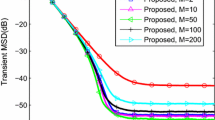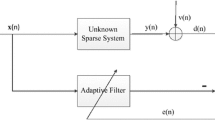Abstract
This paper presents a novel approach for structure extraction of the cluster sparse system identification. Different from adopting \(\ell _1\)-norm constraint to regularize the sparsity in the improved proportionate normalized least mean square (IPNLMS) algorithm, we directly work with the block sparse structure via \(\ell _{1,0}\)-norm constraint. In particular, we develop a cluster sparse IPNLMS by the block \(\ell _0\) norm regularization, named IPNLMS-BL0 method. The cluster sparse constraint is regarded as an extended version for the sparse constraint term. On the other hand, the iterations of IPNLMS-BL0 are derived by the steepest descent strategy. Then, we provide the analysis of block size choices of the cluster sparse constraint, computational complexity, and steady-state error of the proposed method. Various simulations are designed to test the performance of the IPNLMS-BL0 algorithm and its counterparts to identify and track the unknown sparse systems. The results are provided and analyzed to confirm the effectiveness and superiority of the proposed IPNLMS-BL0 algorithm.



Similar content being viewed by others
References
Haykin, S.: Adaptive Filter Theory, 4th edn. Prentice-Hall, Upper Saddle River (2002)
Duttweiler, D.L.: Proportionate normalized least-mean-squares adaptation in echo cancelers. IEEE Trans. Speech Audio Process. 8(5), 508–518 (2000)
Benesty, J., Paleologu, C., Ciochina, S.: Proportionate adaptive filters from a basis pursuit perspective. IEEE Signal Process. Lett. 17(12), 985–988 (2010)
Benesty, J., Gay, S.L.: An improved PNLMS algorithm. In: Proceedings of IEEE ICASSP, pp. 1881–1884 (2002)
Cui, J., Naylor, P., Brown, D.: An improved IPNLMS algorithm for echo cancellation in packet-switched networks. In: Proceedings of EEE International Conference on Acoustics, Speech, Signal Process. (ICASSP04), Montreal, QC, Canada, pp. 141–144 (2004)
Zhu, X., Li, X., Zhang, S.: Block-row sparse multiview multilabel learning for image classification. IEEE Trans. Cyber. 46(2), 450–461 (2016)
Brbic, M., Kopriva, I.: \(\ell _0\)-Motivated low-rank sparse subspace clustering. IEEE Trans. Cyber. 50(4), 1711–1725 (2020)
Angelosante, D., Bazerque, J.A., Giannakis, G.B.: Online adaptive estimation of sparse signals: where RLS meets the \(\ell _1\)-norm. IEEE Trans. Signal Process. 58(7), 3436–3447 (2010)
Hong, X., Gao, J., Chen, S.: Zero attracting recursive least square algorithms. IEEE Trans. Veh. Technol. 66(1), 213–221 (2017)
Wu, F.Y., Yang, K., Duan, R., Tian, T.: Compressive sampling and reconstruction of acoustic signal in underwater wireless sensor networks. IEEE Sens. J. 18(14), 5876–5884 (2018)
Eksioglu, E.M., Tanc, A.K.: RLS algorithm with convex regularization. IEEE Signal Process. Lett. 18(8), 470–473 (2011)
Jahromi, M.N., Salman, M.S., Hocanin, A., Kukrer, O.: Mean-square deviation analysis of the zero-attracting variable step-size LMS algorithm. Signal Image Video Process. 11(3), 533–540 (2017)
Chen, B., Wan, A.: General RIP bounds of \(\delta _{tk}\) for sparse signals recovery by \(\ell _p\) minimization. Neurocomputing 363, 306–312 (2019)
Sun, Y., Lei, L., Li, X., Li, M., Kuang, G.: A robust recovery algorithm with smoothing strategies. Neurocomputing 371, 51–66 (2020)
Zha, Z., Zhang, X., Wang, Q., Tang, L., Liu, X.: Group-based sparse representation for image compressive sensing reconstruction with non-convex regularization. Neurocomputing 296, 55–63 (2018)
Wu, F.Y., Yang, K., Tong, F., Tian, T.: Compressed sensing of delay and Doppler spreading in underwater acoustic channels. IEEE Access. 6, 36031–36038 (2018)
Jiang, S., Gu, Y.: Block-sparsity-induced adaptive filter for multiclustering system identification. IEEE Trans. Signal Process. 63(20), 5318–5330 (2015)
Li, Y., Jiang, Z., Shi, W., Han, X., Chen, B.D.: Blocked maximum correntropy criterion algorithm for block-sparse system identification. IEEE Trans. Circuits Syst. II Exp. Briefs 66(11), 1915–1919 (2019)
Paleologu, C., Benesty, J., Ciochina, S.: An improved proportionate NLMS algorithm based on \(\ell _0\) norm. In: Proceedings of IEEE ICASSP, pp. 309–312 (2010)
Gay, S.L., Douglas, S.C.: Normalized natural gradient adaptive filtering for sparse and non-sparse systems. In: Proceedings of IEEE International Conference on Acoustics Speech Signal Processing, pp. 1405–1408 (2002)
Martin, R.K., Sethares, W.A., Williamson, R.C., Johnson, C.R.: Exploiting sparsity in adaptive filters. IEEE Trans. Signal Process. 50(8), 1883–1894 (2002)
Li, Y., Jiang, Z., Osman, O.M.O., Han, X., Yin, J.W.: Mixed norm constrained sparse APA algorithm for satellite and network echo channel estimation. IEEE Access 6, 65901–65908 (2018)
Liu, J., Grant, S.L.: Proportionate adaptive filtering for block sparse system identification. IEEE/ACM Trans. Audio Speech Lang. Process. 24(4), 623–630 (2016)
Liu, J., Grant, S.L.: Block sparse memory improved proportionate affine projection sign algorithm. Electron. Lett 51(24), 2001–2003 (2015)
Jin, Z., Li, Y., Liu, J.: An improved set-membership proportionate adaptive algorithm for a block-sparse system. Symmetry 10(3), 1–15 (2018)
Wu, F.Y., Yang, K., Hu, Y.: Sparse estimator with \(\ell _0\)-norm constraint kernel maximum correntropy criterion. IEEE Trans. Circuits Systems II Express Briefs 67(2), 400–404 (2020)
Tian, T., Wu, F.Y., Yang, K.D.: Block-sparsity regularized maximum correntropy criterion for structured-sparse system identification. J. Frank. Inst. 357(17), 12960–12985 (2020)
Wu, F.Y., Yang, K., Sheng, X., Huang, F.: A blocked MCC estimator for group sparse system identification. Int. J. Electron. Commun. 115, 153033–153038 (2020)
Pelekanakis, K., Chitre, M.: Natural gradient-based adaptive algorithms for sparse underwater acoustic channel identification. In: Proceedings of 4th Underwater Acoustics and Measurements Conference, Kos Island, Greece, pp. 1403–1410 (2011)
Pelekanakis, K., Chitre, M.: New sparse adaptive algorithms based on the natural gradient and the \(\ell _0\)-norm. IEEE J. Ocean. Eng. 38(2), 323–332 (2013)
Wagner, K., Doroslovacki, M.: Towards analytical convergence analysis of proportion-type NLMS algorithms. In: Proceedings of IEEE International Conference on Acoustics, Speech, and Signal Processing, pp. 3825–3828 (2008)
Acknowledgements
This work was supported in part by National Natural Science Foundation of China (Project No. 61701405), in part by the Fundamental Research Funds for the Central Universities (Project No. 3102019HHZY030022), in part by Natural Science Basic Research Plan in Shaanxi Province of China (Project No. 2019JQ463), in part by Stable Supporting Fund of Acoustic Science and Technology Laboratory, Harbin Engineering University (Project No. JCKYS2019604SSJS014), and in part by China Postdoctoral Science Foundation (Project No. 2019T120957).
Author information
Authors and Affiliations
Corresponding authors
Ethics declarations
Conflict of interest
The authors declare that they have no conflict of interest.
Additional information
Publisher's Note
Springer Nature remains neutral with regard to jurisdictional claims in published maps and institutional affiliations.
Rights and permissions
About this article
Cite this article
Wu, FY., Song, YC., Tian, T. et al. A mixed norm constraint IPNLMS algorithm for sparse channel estimation. SIViP 16, 457–464 (2022). https://doi.org/10.1007/s11760-021-01975-6
Received:
Revised:
Accepted:
Published:
Issue Date:
DOI: https://doi.org/10.1007/s11760-021-01975-6




